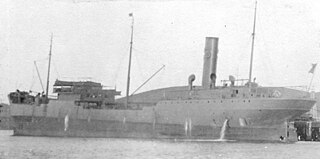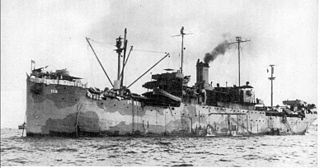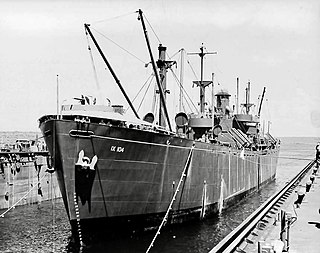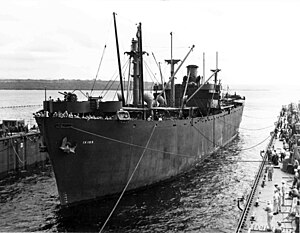
The second USS Abarenda (IX-131) was a storage tanker, one of many miscellaneous-class Navy vessel crewed by the United States Coast Guard during World War II.

USS Abele (AN-58) was a Ailanthus-class net laying ship in the service of the United States Navy, named after Populus alba, commonly called abele, silver poplar, or white poplar.

USS Medusa (AR-1) was the United States Navy's first purpose-built repair ship. She served in the U.S. Navy from 1924 to 1946.

USS Alameda, was a United States Navy tanker in commission from 1919 to 1922. She was built as the civilian tanker SS Alameda, but transferred to the U.S. Navy after completion in 1919. She was sold for commercial service and operated under the names SS Olean and SS Sweep before she was transferred to the Navy again in World War II as USS Silver Cloud (IX-143).

USS Artisan (ABSD-1), later redesignated as (AFDB-1), was a ten-section, non-self-propelled, large auxiliary floating drydock of the United States Navy. The only U.S. warship with this name, Artisan was constructed in sections during 1942 and 1943 by the Everett-Pacific Shipbuilding & Dry Dock Company, in Everett, Washington; the Chicago Bridge & Iron Company, in Eureka, California; the Pollock-Stockton Shipbuilding Company, in Stockton, California; and the Chicago Bridge & Iron Company, in Morgan City, Louisiana. This ship was commissioned at Everett, Washington, on 10 May 1943, Captain Andrew R. Mack in command. With all ten sections joined, she was 927 feet (283 m) long, 28 feet (8.5 m) tall, and with an inside clear width of 133 feet 7 inches (40.72 m).

The USS Guinevere (IX-67) was a patrol vessel of the United States Navy that operated in service from 1942 to 1945.

USS Inca, a 3,381-ton "Liberty" ship, was launched in March 1943 in Los Angeles, California, and entered merchant service later the same month as SS William B. Allison, MCE hull 724. Two years later she would be taken into US Navy as a stores ship and renamed USS Inca (IX-229). For much of her service as Inca she was also named USS Gamage (IX-227) because of bureaucratic confusion.
USS Domino (IX-208), an unclassified miscellaneous vessel, was the only ship of the United States Navy to be named for the game piece. The freighter was acquired from the War Shipping Administration in May 1945. The hull classification symbol IX-208 was reserved for her, but she was never taken up on the list of naval vessels, and no classification was ever assigned to her. She was returned to the War Shipping Administration (WSA) in February 1946.

USS Quapaw (ATF–110/AT-110) was a Abnaki-class fleet ocean tug in the United States Navy. She was named after the Quapaw.
USS Carib (AT-82) was a Cherokee-class fleet tug constructed for the United States Navy during World War II. Her purpose was to aid ships, usually by towing, on the high seas or in combat or post-combat areas, plus "other duties as assigned." She served in the Atlantic Ocean and the Pacific Ocean.
The USS Araner (IX-226) was laid down as the liberty ship Juan de Fuca under a Maritime Commission contract on 15 November 1942 at Vancouver, Washington, by the Oregon Shipbuilding Company and launched on 27 December 1942. The ship was delivered to the War Shipping Administration (WSA) on 11 January 1943 and immediately placed under a standard WSA operating agreement with Weyerhauser Steamship Company.

USS Majaba (AG-43/IX-102) was the Design 1049 cargo ship Meriden built in 1919 by the Albina Engine & Machine Works, Portland, Oregon. All the ships were requisitioned by the United States Shipping Board (USSB) for World War I service. The ship was bought by the E. K. Wood Lumber Co., of San Francisco, California in 1923 and renamed El Capitan. The ship was chartered by the U.S. Navy through the War Shipping Administration (WSA) in April 1942 and commissioned as Majaba.

USS Papago (ATF-160) was an Abnaki-class fleet ocean tug built for the United States Navy during World War II, and named for the American Indian tribe of the Piman family that formerly lived south and southeast of the Gila River in Arizona and the Mexican state of Sonora.

The Powhatan class of fleet ocean tugs consists of seven ships built for the United States Navy, and operated by the Military Sealift Command (MSC). The lead ship of the class was launched in 1978 and the last ship in MSC service will be deactivated in 2023. During their service life, the Powhatan's were the most powerful tugs owned by the Navy.

The Xanthus-class repair ships were a class of five auxiliary ships built for the United States Navy and Royal Navy. Ships of the class served in a diverse range of environments in varying capacities during both World War II and the Korean War. Xanthus-class ships were in commission between 1945–1955.

USS Ocelot (IX–110) was an unclassified miscellaneous vessel of the United States Navy, which served as the flagship of Service Squadron 10 in the Pacific War from late 1944, until she was wrecked in a typhoon in late 1945.

YFD-2 was an auxiliary floating drydock built for the United States Navy in 1901. The first parts were laid down in early 1901 at Maryland Steel Co. of Sparrows Point, Maryland. YFD-2 was the first of its kind, steel movable auxiliary floating drydock, used to raise large ships out the water for repair below the ship's waterline. YFD-2 had a 18,000 tons lifting capacity.

USS Moctobi (ATF-105) was an Abnaki-class of fleet ocean tug. She served in World War II, Vietnam, and Korea, the last two of which she received battle stars. She was scrapped in 2012.

SS Peter H. Burnett was an American Liberty ship built in 1942 for service in World War II. She was later acquired by the United States Navy and renamed USS P.H. Burnett (IX-104). Her namesake was Peter Hardeman Burnett, an American Governor from 1849 to 1851.

SS M. H. De Young was an American Liberty ship built in 1943 for service in World War II. She was later acquired by the United States Navy and renamed USS Antelope (IX-109). Her namesake was M. H. de Young, an American journalist and businessman from 1865 to 1925.

















